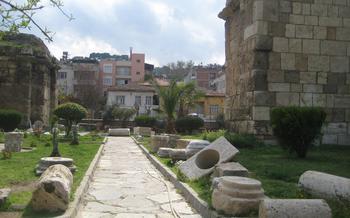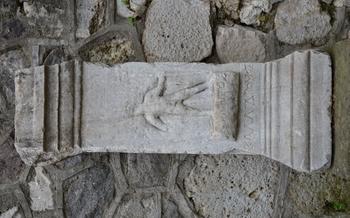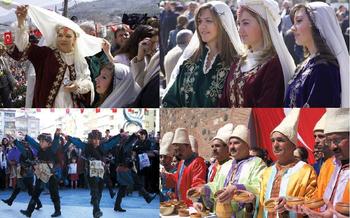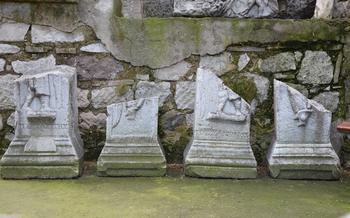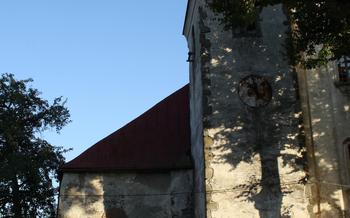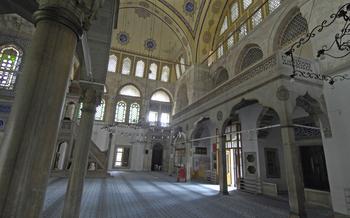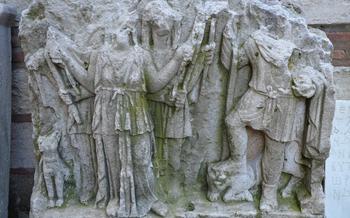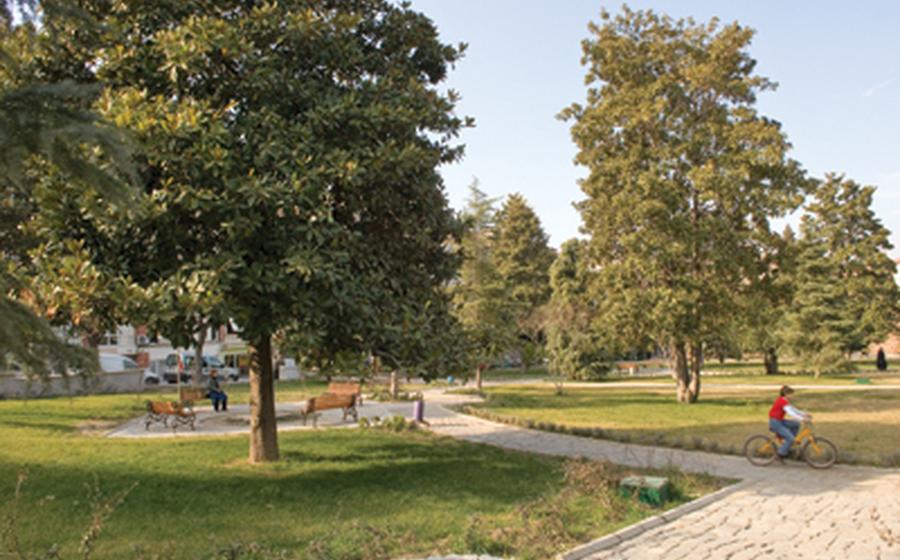
Yedi Kizlar Monastery
- Yedi Kizlar Monastery: An Enchanting Historical Marvel
- Location and Accessibility
- Exploring the Monastery Grounds
- Unraveling the History of Yedi Kizlar
- Legends and Folklore Surrounding the Monastery
- Architectural Highlights of Yedi Kizlar
- Conservation and Restoration Efforts
- Visiting Tips and Practical Information
- Nearby Attractions and Side Trips
- Unforgettable Experiences at Yedi Kizlar
- Tips for Photography Enthusiasts
- Historical Significance and Cultural Impact
- Local Customs and Traditions
- Sustainable Tourism Practices
- Insider Tip: Unveiling a Hidden Gem within the Monastery
Yedi Kizlar Monastery: An Enchanting Historical Marvel
Nestled amidst the serene landscapes of Manisa, Turkey, the Yedi Kizlar Monastery stands as a testament to the region's rich history and religious heritage. This ancient monastery, also known as the Seven Sisters Monastery, is believed to have been established in the 10th century and played a significant role in the development of Christianity in the area. Over the centuries, it underwent various transformations, reflecting the changing political and cultural landscapes of the region. Today, the monastery stands as a poignant reminder of the past, attracting visitors with its captivating blend of history, architecture, and spirituality.
The monastery's name, Yedi Kizlar, meaning "Seven Sisters," is derived from a poignant legend that has been passed down through generations. According to the tale, seven Christian sisters sought refuge within the monastery's walls to escape forced conversions during a period of religious persecution. Tragically, their pursuers caught up to them, leading to their martyrdom. This legend has become an integral part of the monastery's identity, adding to its mystique and allure.
Location and Accessibility
The Yedi Kizlar Monastery is situated in the picturesque village of Kiraz, nestled amidst the foothills of Mount Spil in the province of Manisa, Turkey. Its strategic location on the ancient trade routes connecting the Aegean coast to the inland regions made it a significant religious and cultural center in the past. Today, the monastery stands as a testament to the region's rich history and cultural heritage.
Reaching Yedi Kizlar Monastery is relatively easy, with several transportation options available. Visitors can take a scenic bus ride from the city of Manisa, which offers regular services to Kiraz village. Alternatively, renting a car or hiring a taxi provides the flexibility to explore the surrounding areas at your own pace. The monastery is well-signposted and accessible by road, making it convenient for self-guided exploration.
The monastery's proximity to major cities like Izmir and Bursa makes it an ideal day trip or a stopover for travelers exploring the region. While there are no guided tours specifically for the monastery, visitors can opt for local guides in Kiraz village who can provide insights into the history and significance of the site. With its accessible location and ease of exploration, Yedi Kizlar Monastery welcomes visitors to immerse themselves in its captivating history and architectural splendor.
Exploring the Monastery Grounds
The Yedi Kizlar Monastery comprises an array of structures that reflect its rich history and religious significance. As you explore the monastery complex, you'll encounter various sections, each possessing unique architectural features and historical charm.
The heart of the monastery is the church, a testament to Byzantine craftsmanship. Adorned with intricate frescoes and mosaics depicting biblical scenes, the church exudes a sense of awe and reverence. The vibrant colors and expressive figures bring to life stories from the Bible, offering a glimpse into the beliefs and practices of the monastic community.
Adjacent to the church is the refectory, where the monks once gathered for communal meals. This spacious hall features vaulted ceilings and long tables, evoking a sense of brotherhood and shared purpose. The refectory also showcases stunning frescoes depicting scenes from everyday monastic life, providing insights into the daily routines and rituals of the monks.
Beyond the church and refectory, you'll discover the living quarters of the monks, arranged in a series of cells. These modest rooms, often adorned with simple decorations, offer a glimpse into the austere lifestyle of the monastic community. The cells provide a tangible connection to the individuals who dedicated their lives to prayer and contemplation within these sacred walls.
Throughout the monastery, you'll encounter intricate stone carvings and decorative elements that speak to the skill and artistry of the Byzantine craftsmen. From the delicate moldings adorning the doorways to the elaborate capitals atop the columns, each detail contributes to the overall grandeur of the monastery.
Finally, don't miss the opportunity to ascend to the monastery's terraces, where you'll be rewarded with breathtaking panoramic views of the surrounding landscape. Overlooking the lush forests and distant mountains, these terraces offer a moment of tranquility and reflection, inviting you to soak in the beauty of nature and contemplate the enduring legacy of this ancient monastery.
Unraveling the History of Yedi Kizlar
The origins of Yedi Kizlar Monastery are shrouded in mystery and legend, with various accounts and traditions contributing to its rich history. According to one narrative, the monastery was founded in the 11th century by a group of monks seeking refuge from religious persecution. Over time, it grew into a thriving religious community, attracting pilgrims and scholars from across the region.
During the Byzantine period, Yedi Kizlar flourished as a center of learning and spirituality. Monastic life revolved around prayer, study, and manual labor. The monks cultivated the surrounding land, producing food and other goods to sustain themselves and the local community. They also maintained a scriptorium, where they copied and illuminated manuscripts, contributing to the preservation and transmission of knowledge.
In the 15th century, the region fell under Ottoman rule. While the monastery was allowed to continue functioning, it faced challenges and restrictions. The Ottomans imposed taxes on the monks and gradually reduced their autonomy. Despite these difficulties, Yedi Kizlar remained an important religious and cultural center throughout the Ottoman period.
Over the centuries, the monastery underwent various transformations and renovations. It was expanded and embellished with new architectural features, reflecting the changing tastes and influences of different eras. Today, Yedi Kizlar stands as a testament to its rich and complex history, embodying the diverse cultural and religious heritage of the region.
Legends and Folklore Surrounding the Monastery
The Yedi Kizlar Monastery is shrouded in legends and folklore that have captivated the imaginations of visitors for centuries. The most famous legend is the tale of the seven sisters who were forced to convert to Islam during the Ottoman conquest. Rather than submit, they chose to leap from the monastery's highest tower, symbolizing their unwavering faith and defiance.
Some believe that the seven sisters' spirits still haunt the monastery, appearing as ethereal figures in the moonlight. Others claim to have heard their voices echoing through the ancient corridors, lamenting their tragic fate. These stories have added an air of mystery and intrigue to the monastery, attracting visitors who seek to unravel the truth behind the legends.
In addition to the legend of the seven sisters, the monastery is associated with various other tales and myths. Some believe it was once a sanctuary for lost souls, where weary travelers could find refuge and guidance. Others whisper of hidden treasures buried within the monastery walls, waiting to be discovered by those who possess the courage to seek them.
These legends and folklore have played a significant role in shaping the monastery's mystique and allure. They have transformed it into a place of wonder and enchantment, where visitors can immerse themselves in the realm of myth and imagination, while exploring the rich historical and cultural heritage of the Yedi Kizlar Monastery.
Architectural Highlights of Yedi Kizlar
The Yedi Kizlar Monastery stands as a testament to the remarkable craftsmanship and artistic prowess of the Byzantine era. Constructed in the 11th century, the monastery boasts a distinctive architectural style that blends elements of early Christian and Byzantine design. Its sturdy stone walls, intricate carvings, and stunning frescoes create a visually captivating ensemble.
The interior of the monastery is adorned with a series of well-preserved frescoes that depict scenes from the Bible, as well as portraits of saints and religious figures. These vibrant and expressive paintings offer a glimpse into the artistic traditions and theological beliefs of the Byzantine period.
Intricate stone carvings adorn the exterior and interior of the monastery, showcasing the exceptional skill of Byzantine artisans. Geometric patterns, floral motifs, and depictions of animals and mythical creatures intricately embellish the walls, columns, and arches. The attention to detail and the harmonious blending of these decorative elements create a sense of awe and wonder.
Comparing Yedi Kizlar Monastery with other Byzantine monasteries in the region reveals both similarities and unique characteristics. While sharing common architectural features such as the cruciform layout, domed roofs, and narthex, Yedi Kizlar stands out with its relatively small size and the presence of a single dome instead of the more common multiple domes. Its compact design and the integration of natural elements into its surroundings contribute to its distinctive charm.
Overall, the architectural features of Yedi Kizlar Monastery embody the essence of Byzantine aesthetics and craftsmanship. The harmonious blend of structural elements, decorative details, and religious iconography creates a sacred space that invites contemplation and spiritual connection.
Conservation and Restoration Efforts
Protecting and preserving the rich heritage of Yedi Kizlar Monastery has been a continuous endeavor involving local authorities, international organizations, and dedicated individuals. Over the years, the monastery has faced various challenges, including natural decay, neglect, and the impact of human activities.
Restoration projects have been undertaken to address these issues and ensure the monastery's longevity. These projects have focused on structural repairs, restoration of frescoes and mosaics, and the conservation of architectural elements. Skilled artisans and experts in Byzantine art have collaborated to meticulously restore the monastery's intricate details.
International organizations such as UNESCO have provided support and expertise in the restoration efforts, recognizing the monastery's significance as a cultural heritage site. Through collaboration and funding, these organizations have helped preserve the monastery's unique features and ensure its accessibility to future generations.
Ongoing efforts to protect and maintain the site include regular monitoring, preventive measures against further deterioration, and the development of sustainable tourism practices. Local authorities and stakeholders work together to raise awareness about the importance of preserving this historical gem and to ensure its continued existence as a symbol of Byzantine heritage.
By preserving Yedi Kizlar Monastery, we not only protect a physical structure but also safeguard the cultural and historical legacy it represents. The restoration and conservation efforts contribute to the preservation of our shared heritage and allow us to continue to appreciate the beauty and significance of this architectural masterpiece for years to come.
Visiting Tips and Practical Information
To make the most of your visit to Yedi Kizlar Monastery, keep these practical tips in mind:
Best Time to Visit: Aim for spring (April-May) or autumn (September-October) to avoid the scorching summer heat and enjoy pleasant weather. Crowds are generally smaller during these shoulder seasons.
Duration: Allocate at least two to three hours for a comprehensive exploration of the monastery grounds, including time to admire the architecture, soak in the atmosphere, and learn about its history.
Dress Code: Respect the religious nature of the site by dressing modestly. Avoid shorts, tank tops, and revealing clothing.
Guided Tours: Guided tours are available in various languages, providing valuable insights into the monastery's history and significance. Check with the local tourism office for schedules and prices.
Signage: The monastery is well-equipped with multilingual signage, making it easy for visitors to navigate and understand the site's features.
Nearby Attractions and Side Trips
Beyond the captivating Yedi Kizlar Monastery, Manisa offers a wealth of other historical and cultural treasures. The ancient city of Sardis, once the capital of the Lydian Empire, lies just a short distance away, boasting impressive ruins, a restored synagogue, and the renowned Artemis Temple.
For those seeking natural wonders, the mesmerizing Spil Mountain National Park beckons with its verdant forests, cascading waterfalls, and breathtaking views. Explore the park's scenic trails, encounter diverse flora and fauna, and immerse yourself in the tranquility of nature.
Indulge in the region's culinary delights by savoring the flavors of traditional Turkish cuisine. Manisa is renowned for its delectable dishes, including Manisa kebabı, keşkek, and gözleme. Treat your palate to these culinary masterpieces at local restaurants or in the vibrant markets.
Outdoor enthusiasts will find ample opportunities for adventure in the surrounding area. Embark on invigorating hikes through scenic landscapes, challenge yourself with thrilling mountain biking trails, or experience the tranquility of fishing in picturesque lakes.
Unforgettable Experiences at Yedi Kizlar
A visit to the Yedi Kizlar Monastery offers a multitude of unforgettable experiences that transcend mere sightseeing. Immerse yourself in the rich religious heritage of the region by attending one of the many festivals or events held at the monastery throughout the year. These celebrations, often accompanied by traditional music, dance, and local delicacies, provide a glimpse into the vibrant culture of the area.
For those seeking a deeper connection with the monastery's spiritual essence, cultural workshops and demonstrations offer a unique opportunity to learn about Byzantine art, iconography, and monastic life. Engage in hands-on activities such as candle-making, pottery, or calligraphy, and discover the hidden meanings and symbolism embedded within the monastery's architecture and iconography.
Take advantage of the monastery's elevated position to capture breathtaking panoramic views of the surrounding landscape. Gaze upon the rolling hills, lush forests, and distant mountain peaks, all while immersing yourself in the tranquility and serenity that permeate the monastery grounds. Find a secluded spot to sit and contemplate, allowing the peaceful ambiance to wash away the stresses of daily life.
As you wander through the monastery's corridors and courtyards, let your imagination soar as you envision the monks who once called this place home. Feel the weight of history as you trace their footsteps, imagining their daily routines, their prayers, and their struggles. Experience the profound sense of peace and spiritual connection that lingers within these ancient walls, leaving an indelible mark on your soul long after your visit has ended.
Tips for Photography Enthusiasts
For photography enthusiasts, the Yedi Kizlar Monastery presents a treasure trove of opportunities to capture stunning images. The monastery's unique architecture, intricate details, and picturesque surroundings offer a variety of subjects to explore through the lens.
To make the most of your photography experience, consider the following tips:
-
Harness the Golden Hour: Plan your visit during the golden hours of sunrise or sunset to capture the monastery bathed in warm, diffused light. This soft lighting enhances the textures and colors of the stonework, creating a magical atmosphere.
-
Utilize a Tripod and Wide-Angle Lens: Bring a sturdy tripod to stabilize your camera and avoid blurry shots. A wide-angle lens is ideal for capturing the grandeur of the monastery's architecture and the sweeping views from its terraces.
-
Experiment with Perspectives: Don't be afraid to experiment with different angles and perspectives to create unique and dynamic compositions. Try shooting from low angles to emphasize the monastery's imposing height or from above to capture the intricate details of its rooftops.
-
Respect the Sanctity of the Site: While capturing the beauty of the monastery, remember to respect the sanctity of the site. Be mindful of religious ceremonies and avoid disturbing the tranquility of the المكان.
Historical Significance and Cultural Impact
Yedi Kizlar Monastery stands as a significant historical landmark, embodying the region's rich cultural heritage. Its existence as a religious sanctuary for centuries has deeply influenced the area's religious and cultural landscape. The monastery represents a time-honored tradition of monasticism, where individuals sought spiritual enlightenment and communal living.
The architectural style, artistic expressions, and intricate details found within the monastery's walls showcase the mastery of Byzantine craftsmanship. The stunning frescoes and mosaics, along with the intricate stone carvings, provide a glimpse into the artistic prowess of the era. Yedi Kizlar Monastery serves as a testament to the enduring legacy of Byzantine art and architecture.
Moreover, the monastery's enduring presence has woven it into the fabric of local folklore and legends. The tragic tale of the seven sisters has been passed down through generations, adding a layer of mystique and cultural significance to the site. These stories have captured the imagination of locals and visitors alike, creating a sense of wonder and enchantment that surrounds the monastery.
Recognizing its immense historical and cultural value, Yedi Kizlar Monastery has been designated as a protected historical monument. This recognition underscores the importance of preserving and safeguarding this unique site for future generations. The monastery stands as a symbol of the region's rich heritage, inviting visitors to delve into its history, admire its architectural splendor, and experience the spiritual essence that lingers within its walls.
Local Customs and Traditions
When visiting Yedi Kizlar Monastery, it is essential to be respectful of the local customs and traditions. As a religious site, the monastery holds deep spiritual and cultural significance for the local community. Visitors should dress modestly and avoid wearing revealing or disrespectful clothing. It is also important to be mindful of noise levels and refrain from loud conversations or disruptive behavior.
Engaging with the local community can be a rewarding experience. Visitors can interact with the friendly locals, learn about their traditions, and gain insights into their way of life. By respecting local customs and traditions, tourists can contribute to the preservation of the region's rich cultural heritage.
Sustainable Tourism Practices
As a responsible traveler, it's essential to adopt sustainable practices that minimize your environmental impact while visiting Yedi Kizlar Monastery. Embrace the principles of responsible tourism by supporting local businesses that prioritize sustainability. Choose accommodations that prioritize energy efficiency and waste reduction, and savor local cuisine prepared with fresh, seasonal ingredients. Respect the natural beauty of the surroundings, avoiding littering and noise pollution. Encourage others to adopt sustainable travel practices, creating a positive impact on the environment and preserving the monastery's heritage for future generations.
Insider Tip: Unveiling a Hidden Gem within the Monastery
Beyond the main attractions of Yedi Kizlar Monastery, there lies a hidden gem waiting to be discovered. Tucked away in a secluded corner of the complex, a lesser-known chapel or secret passage awaits exploration. This hidden treasure holds its own unique stories and symbolism, adding another layer of intrigue to the monastery's already rich history.
To uncover this secret spot, visitors may need to seek guidance from local experts or delve deep into the monastery's history to find clues. Once discovered, the hidden chapel or passage offers a glimpse into the private lives of the monks who once resided here, revealing their devotion, struggles, and aspirations.
Exploring this secret gem requires respect and consideration for the sanctity of the site. Visitors should tread lightly, mindful of the fragile nature of the historical remains. By uncovering the hidden stories and symbolism associated with this hidden gem, travelers can gain a deeper appreciation for the monastery's enduring legacy and the diverse narratives it holds.
Remember, the true essence of Yedi Kizlar Monastery lies not only in its grandeur but also in the hidden stories that await discovery. Embrace the opportunity to explore this secret chapel or passage responsibly, allowing yourself to be captivated by the monastery's untold tales and the magic that lingers within its ancient walls.
